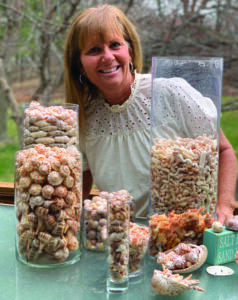Wendi Peterson is a collector, but her desired objects are very specific: the myriad forms of seashells that wash up on the ocean’s margins, and she has quite a collection. It began when she first took her 4-year-old daughter to a beach many years ago. It just happened to be at Marco Island, Florida, well-known for its shells. It was the first time they had been to a place with beaches. “Since then,” Wendi says, “shell collecting has become my not-so-secret obsession. Nowadays, I target ever more unusual shells to search for, and when I’m on a beach, I rarely sunbathe—I’m always looking for shells.” Like serious collectors of anything, she has learned much about the nomenclature and biology of her hobby through contact with other enthusiasts. There is much to learn; it is estimated that there are over 100,000 species of mollusks that create shells. Each year, Wendi travels from her home in Minnesota for a few days in Florida, whose Gulf Coast offers some of the best shelling in the country, and there she joins other shell-seekers and spends much of her days wandering the beaches at low tide in search of increasingly less common forms. There are worse things you can do!

Seashells are the external skeletons of soft-bodied marine mollusks such as gastropods (snails) and bi-valves (clams, cockles, oysters, mussels, scallops, etc.). They are primarily defensive armor against predators, but they also double as a home. Shells have three layers and are composed of two crystalline forms of calcium carbonate with a small quantity of protein (less than 2 percent). They grow from the inside out and by adding material at the edge of the opening. As the mollusk grows, the shell must enlarge and grow structurally stronger, too. The outer part of the enclosed, soft organism that is in contact with the inner surface of the shell is called the mantle. Its job is to secrete the proteins and minerals that form the shell. First, a layer of protein and chitin1 forms, the chitin acting as a sort of scaffold on and by which the appropriate crystallization of the following calcium carbonate layers is directed. The highly calcified middle layer is of calcite, while the inner pearly layer, called nacre or mother of pearl, is composed of aragonite. The two different crystal structures together provide much greater strength and resistance to damage. (Incidentally, the iridescence of the interior nacre occurs because the aragonite crystal platelets function like a diffraction grating2 in dispersing visible light).
It may not be high on your list of interests, but most mollusks have a sex life, but because of the extremely wide numbers of different forms that comprise the mollusk family, unsurprisingly it presents itself in many different ways. Most species reproduce sexually by the union of egg and sperm released into the ocean during mating, much as fish do, while some forms are hermaphroditic, possessing both male and female reproductive organs. Sometimes these are alternately functional at rhythmic intervals, and in others they are simultaneous. Other mechanisms also exist. Eggs are deposited on hard surfaces, often in jelly-like masses or leathery capsules. In the majority of cases, when the eggs hatch, they become free-swimming larvae that develop the organs that produce the shell, mantle cavity, or foot as they grow. After a time, they metamorphose into the adult stage, begin shell formation, and start their regular life.
Mollusks have been around since early Cambrian times around 550 million years ago and pre-date the possibly better known trilobites in the fossil record. The oldest living mollusks are slow-growing bi-valves in the north Atlantic believed to live for several hundred years. Bi-valves, like clams, mussels, oysters and scallops, live for decades while the longevity of gastropods (snails, limpets, sea slugs, etc.) can be anything from months to 20 years for large snails such as conch.

All of this is of scientific interest, but to the average beachcomber it is the beauty, wondrous variety and geometrical perfection of these treasures of the sea that beckons people to spend days collecting them. They hope, no doubt, to find that rarest of North American shells, the Junonia, which can fetch up to $300 for a good, large (4-6 inch) specimen. It is rare since the animal’s habitat lies far offshore in water between 100-400 feet deep, and the shells rarely wash up on beaches undamaged.
Here’s a riddle for you: what sea animal has no back or front, no head or tail, only a top and bottom and is inexpensive? The answer is another “shell” often collected: the sand dollar. In fact it isn’t a shell at all; it is a flat, burrowing cousin of sea urchins and sea stars that lives for 6 to 10 years. Live animals in water are covered in small, densely packed spines of gray or purple color that obscure the typical, five-pointed, flower-like pattern on their backs. They are invertebrates, like the gastropods, having no backbone. The ‘shell’ is actually an exoskeleton called a ‘test,’ composed of calcium carbonate like mollusk shells. They feed on the tiny larvae of crustaceans, algae and other organic detritus, shifting their catch to the mouth, located on the underside, with their spines. It has five rows of tiny teeth there.
The sand dollar has a religious legend attached to it that is favored at Easter. The top surface has five perforations (sometimes slits) said to represent Christ’s wounds. The petallike markings grouped around a five-pointed star resemble the Easter lily with the Bethlehem star in the middle. You may not want to break open your sand dollar, but inside there are five, loose, v-shaped “bones” that resemble flying doves. A stanza of the legend’s poem reads: “Now break the center open and here you will release the five white doves awaiting to spread Good Will and Peace.” We certainly need that right now! The five bones are actually the jaws and teeth the sand dollar uses to grind up its prey.
On that first day, Wendi and her daughter were just picking up broken shell pieces that caught their eye when they met a woman in her eighties who showed them her finds of complete shells and where to look. Says Wendi, “Shelling people are often understandably aloof and possessive, but that woman was so open to helping us that, since then, I’ve always made a point of telling people who are beginning what to look for and where is best.” For Wendi, that includes kayaking to small, offshore islands or wading waist-deep across rivers and inlets to reach off-the-beaten-track shores. It just shows how a simple day at the beach can escalate into a lifelong, absorbing passion. Even some of the sport-fishing boats on Florida’s Gulf Coast have recently found it more profitable to take shell-seekers to outlying islands in search of great shells and the fabled Junonia than their regular occupation.
1 Chitin is one of the most abundant biodegradable polymers produced in nature, second only to cellulose. It is a polysaccharide also found in fungi and crustaceans and forms the outer body of insects.
2 A diffraction grating splits a beam of visible light into several beams of different direction. This can produce coloration that varies when the angle of incident light or observation changes.
© David Cuin 2022


